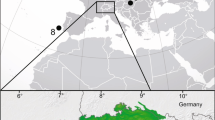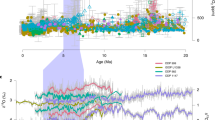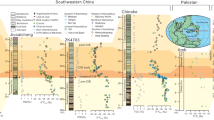Abstract
Arising from: H. Ohmoto, Y. Watanabe & K. Kumazawa Nature 429, 395–399 (2004); see also communication from N. H. Sleep; H. Ohmoto & Y. Watanabe reply Ohmoto et al.1 argue that carbon dioxide was abundant in the late Archaean and early Proterozoic atmosphere and that methane was probably scarce, based on a reanalysis of the occurrence of siderite, FeCO3, in ancient rocks. Here I consider several factors that may undermine their conclusions.
Similar content being viewed by others
Main
Rye et al.2 placed an upper limit on atmospheric carbon dioxide partial pressure, pCO2, between 2.2 billion and 2.8 billion years (2.2 and 2.8 Gyr), based on the absence of siderite in palaeosols (soils that are more than 2.5 billion years old). Ohmoto et al. discount this result because they argue, quoting my atmospheric models3,4, that the oxygen partial pressure (pO2) was too high to allow siderite to be stable. In doing so, they confuse locally generated pO2 values of up to 10−6 atm in the immediate vicinity of oxygen oases4 with globally averaged values of about 10−13 atm, and they ignore the much higher partial pressures (10−5 to 10−3 atm) of hydrogen and methane in these model atmospheres. If one includes these latter gases in equilibrium groundwater calculations, then the effective pO2 is below 10−70 atm and siderite is stable, so the Rye et al. conclusions stand.
Ohmoto et al. argue that the occurrence of siderite in Archaean/early Proterozoic banded iron formations places a lower limit on atmospheric pCO2 at that time, but this argument is not convincing. Banded iron formations are marine sediments that must have been formed below the wave base as otherwise their laminated texture would not have been preserved. Today, the effective pCO2 in deep water is about three times higher than that in surface water as a consequence of the decomposition of organic matter5. If such gradients in dissolved carbon dioxide existed in the Archaean era as well, the pCO2 estimates derived from this procedure will be systematically high by this same amount.
Two other points are relevant. First, atmospheric methane and carbon dioxide levels need not have been inversely correlated. They are inversely correlated only if one can show that the Archaean/early Proterozoic climate was cool. This was clearly the case during the Palaeoproterozoic glaciations at around 2.3 Gyr; however, the surface temperature both before and after that time could have been much warmer. A mean temperature of 70 °C has been proposed for 3.3 Gyr ago6. If the Archaean climate was hot, both methane and carbon dioxide could have been abundant. Second, contrary to the assertions by Ohmoto et al., the idea that Archaean methane levels were high was not proposed initially by Rye et al.2, nor does it rest exclusively, or even primarily, on the palaeosol evidence for low pCO2. A methane-rich Archaean atmosphere was suggested more than 25 years ago7 and was explored during the 1980s by using both photochemical and climate models8,9. If atmospheric oxygen was low10,11, and if methanogens are evolutionarily ancient, high methane levels are predicted, regardless of the particulars of Archaean carbon dioxide levels and climate.
References
Ohmoto, H., Watanabe, Y. & Kumazawa, K. Nature 429, 395–399 (2004).
Rye, R., Kuo, P. H. & Holland, H. D. Nature 378, 603–605 (1995).
Kasting, J. F. Precambrian Res. 34, 205–229 (1987).
Pavlov, A. A., Kasting, J. F. & Brown, L. L. J. Geophys. Res. 106, 23267–23287 (2001).
Broecker, W. S. & Peng, T. -H. Tracers in the Sea (Lamont Doherty Geol. Obs., Palisades, New York, 1982).
Knauth, P. & Lowe, D. R. Geol. Soc. Am. Bull. 115, 566–580 (2003).
Walker, J. C. G. Evolution of the Atmosphere (Macmillan, New York, 1977).
Kasting, J. F., Zahnle, K. J. & Walker, J. C. G. Precambrian Res. 20, 121–148 (1983).
Kiehl, J. T. & Dickinson, R. E. J. Geophys. Res. 92, 2991–2998 (1987).
Farquhar, J., Bao, H. & Thiemans, M. Science 289, 756–758 (2000).
Pavlov, A. A. & Kasting, J. F. Astrobiology 2, 27–41 (2002).
Author information
Authors and Affiliations
Rights and permissions
About this article
Cite this article
Kasting, J. Archaean atmosphere and climate. Nature 432, 1 (2004). https://doi.org/10.1038/nature03166
Published:
Issue Date:
DOI: https://doi.org/10.1038/nature03166
This article is cited by
-
Archaean palaeosols and Archaean air (reply)
Nature (2004)
Comments
By submitting a comment you agree to abide by our Terms and Community Guidelines. If you find something abusive or that does not comply with our terms or guidelines please flag it as inappropriate.



